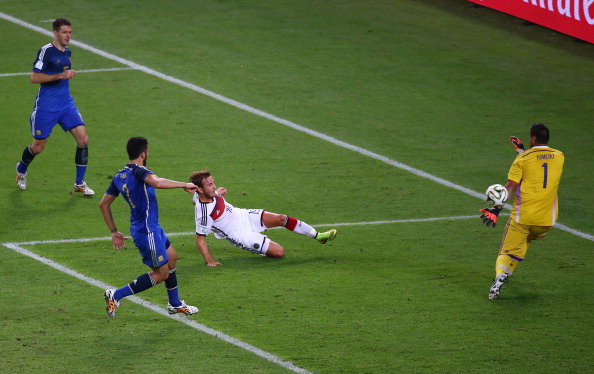OK, soccer freaks. Now that the 2014 FIFA World Cup is over, it's back to reality. Like it or not, this is the fact: in the United States, football, Peyton Manning-style, is king. A release issued Wednesday from the National Football Foundation & College Hall of Fame underscores the truth, and shows just how far the United States has to go before it can truly compete on the international stage with the likes of Germany, winners of soccer’s big prize.
It’s not so much that the United States is bad in soccer. It’s not. It’s just that it’s not good — or, to be more precise, good enough.The difference is thoroughly evident in the way in the way the two countries approach their national sports.
Seven new college football teams will take the field this upcoming season, according to the release, increasing the number of schools across all NCAA divisions and the NAIA offering football to 767, an all-time high.
Welcome, Arizona Christian University (go Firestorm!), The College of Idaho, George Fox University, Limestone College, Missouri Baptist University, Paine College and Southeastern University.
For the geographically minded: George Fox is in Oregon, Limestone in South Carolina, Paine in Georgia, Southeastern — yes — in Florida.
Since 1978, when the NCAA changed its method for keeping attendance, the number of schools playing NCAA football has gone from 484 to 657, or an average of 4.9 schools per year. That includes FBS, FCS, Division II and Division III.
Over the years 2011-13, 25 programs have been added at NCAA or NAIA schools.
The release quoted NFF chairman Archie Manning — the former NFL star who has had a second act as celebrity dad to both Peyton and younger brother Eli, both Super Bowl-winning quarterbacks — as saying that more than one million high school students play football, and that 70,000 play college ball.
It's clear that in the United States young men see in football incredible opportunity, economic and otherwise. This is why in vast numbers they prefer football to soccer. To complete the syllogism, this is why soccer has such an uphill road in the United States.
In the United States, football — starting in high school, perhaps even earlier — is a year-round venture, everything from seven-on-seven summer camps to “Friday Night Lights” and everything that goes with it to the big-time of playing college ball in front of 100,000 or more people. And then, of course, there’s the NFL.
Football holds a special status in the United States. “It’s almost a religion here,” Paine athletics director Tim Duncan said in the NFF release, meaning in the South.
How is soccer supposed to compete?
How, too, is American soccer supposed to compete with what is going on in Germany — where a standardized nationalized program starts teaching the same skills to 6-year-olds everywhere, not just from Munich to Hamburg to Berlin but in every little village. By the time boys are 8, scouts are on the lookout for the ones good enough for club teams.
The German program got started after a humiliating performance in the European 2000 championships. It took 14 years — yes, there was that 2006 World Cup semifinal — to ultimately prove itself. And now the system is in place for years to come.
If you want to read all about the German program, the Guardian, the British newspaper, wrote an excellent feature in May, 2013, all about it.
Without a similar transformation, the United States is, most experts agree, likely stuck where it is for years to come in international soccer.
Such a transformation, however, is going to take time. That’s why Jürgen Klinsmann was brought on for more than just this 2014 World Cup and why he insisted he be named not just the U.S. coach but technical director.
Consider the German team that won in Brazil: Thomas Müller, Mesut Özil, André Schürrle, Mario Götze (who scored the decisive goal against Argentina), and more — these guys are all in their young or mid-20s.
And it has all been building, like a train coming down the tracks. You could see it in 2009, in Sweden, when the Germans beat England, 4-0, to win their first Euro under-21 championship, Özil setting up two goals and scoring another. Six of the players on that 2009 team played key roles in Brazil 2014.
One of the players on that German team, Fabian Johnson, who has a German mother and an American father, switched to the United States in 2011; he played in all four games in Brazil for the United States.
Much as Klinsmann might try, he can’t field an entire team made up of German-Americans.
Long term, the only way the American team is going to get better is by doing it the American way — just the way the Germans got better by doing it the German way.
It’s so obvious that in Europe there’s a club system and in the United States the focus has traditionally been the university.
And yet men’s college soccer is at such a disadvantage when it comes to the big sell.
If the game wants to get bigger in the United States, it has to take advantage of what it has.
Currently, a men’s Division I soccer team is capped at 9.9 scholarships per school. Consider: Michigan had to spread those 9.9 scholarships around the 25 players on its 2013 roster. Stanford, 27. Consider further: Alabama doesn’t even field a men’s varsity soccer team.
Each school, of course, had the maximum total of 85 football scholarships.
If you are a young man with physical talent, and you want to go to a school like Michigan, Stanford or Alabama, and there are abundant reasons to consider any of the three, would you be more likely while in high school to lean toward soccer or football?
Archie Manning notes that 70,000 young men play college football. The stats say 37,240 played college soccer in 2013. That’s a ratio of nearly 2 to 1.
If you dig deeper, moreover, of the 37,240, only 5,691 played Division 1 soccer.
The majority, 11,416, played at the Division III level.
Meaning no disrespect to these young men, because they are out their training, sweating and giving of their time and commitment — but the issue here is not their dedication. That’s a given.
The issue here is if and how the United States is ever going to be a world-class player like Germany. And it is not likely to get there with Division III talent.
You want Americans to compete for real in soccer? Start with the 6-year-olds. Meanwhile, figure out how to fully fund soccer scholarships at the very best schools, and don’t get all hung up on Title IX issues, because if you really want to get good at soccer, this is going to take serious resource and the very best schools are where the very best talent goes. Then keep that talent here in MLS and pay them like honest professionals. Give the whole thing 10 to 15 years, like the Germans.
Then you won’t have to depend on Tim Howard to make 16 saves, and his mother to say he should have made 17.
Until then, soccer freaks, consider this:
Duncan, the Paine athletic director, said the school added 150 student-athletes in the year after it announced it was adding football, increasing enrollment by 11 percent at the historically black college.
Already they have 28 football scholarships — above the conference average of 25.
Easy math: that’s already roughly three times the number of soccer scholarships at a Division I school. That equals opportunity.
Then there’s the University of Texas of the Permian Basin, in Odessa, home of “Friday Night Lights.” In the planning stages of adding football, the university must raise $9.5 million by the end of 2014, and appears to be on track. “We’re fully planning on being a successful football team,” university president W. David Watts said, the team intending to start playing in the 2016 season.
This is it exactly. If there's $9.5 million for football in Odessa, and you want soccer to succeed in the United States for real -- this is how you make it happen. You have to step it up. In Odessa and everywhere. You make soccer the priority that football is. It's that simple.
Along those lines:
On Tuesday, Jimmy Graham of the New Orleans Saints signed a four-year, $40-million contract that makes him the highest-paid tight end in the NFL.
Every teen boy with athletic talent can do that kind of math, and then logic says he is bound to ask this easy question that is very, very hard for every reasonable-thinking person looking at the opportunity upside to answer:
Soccer — why me?



